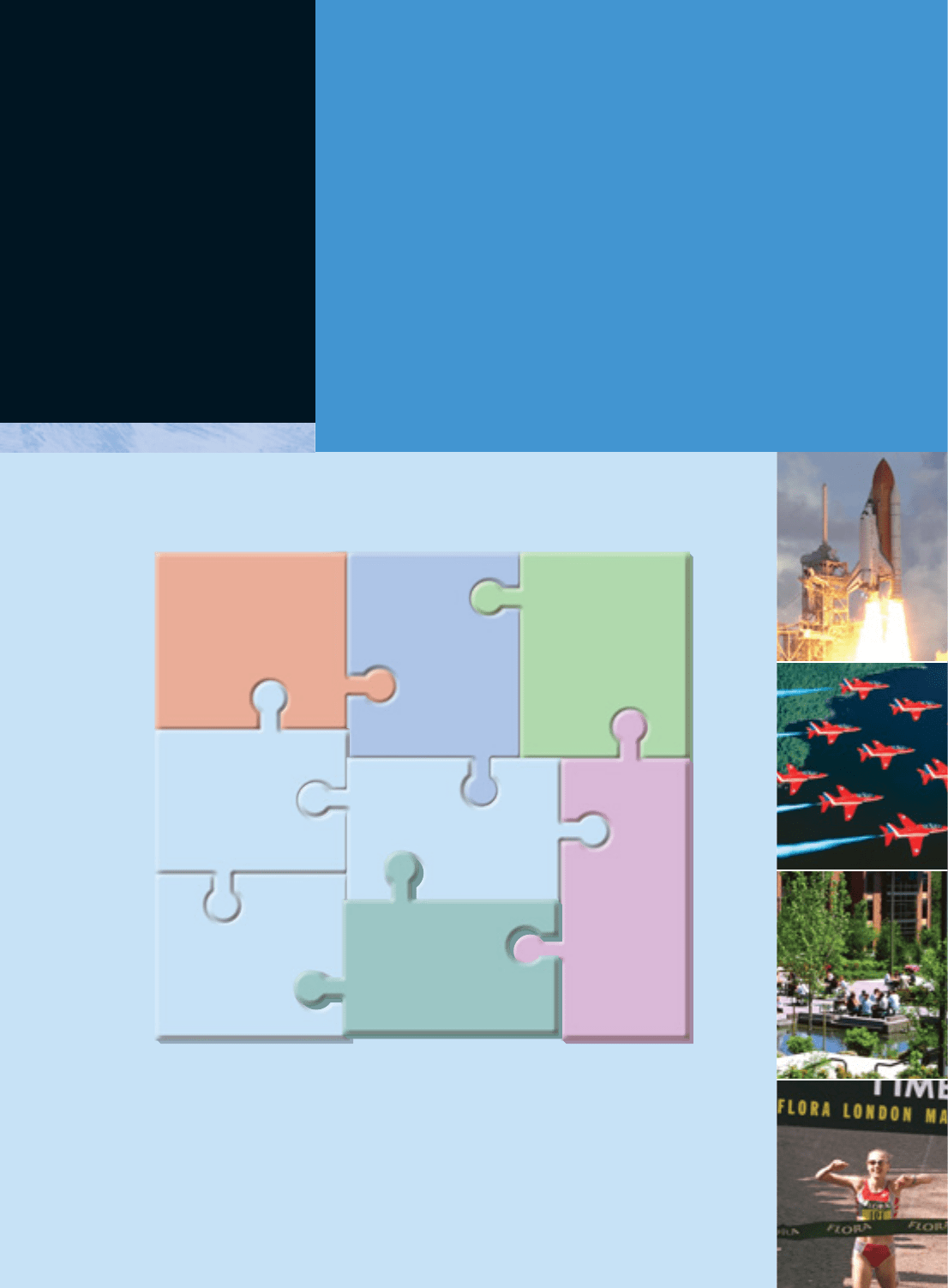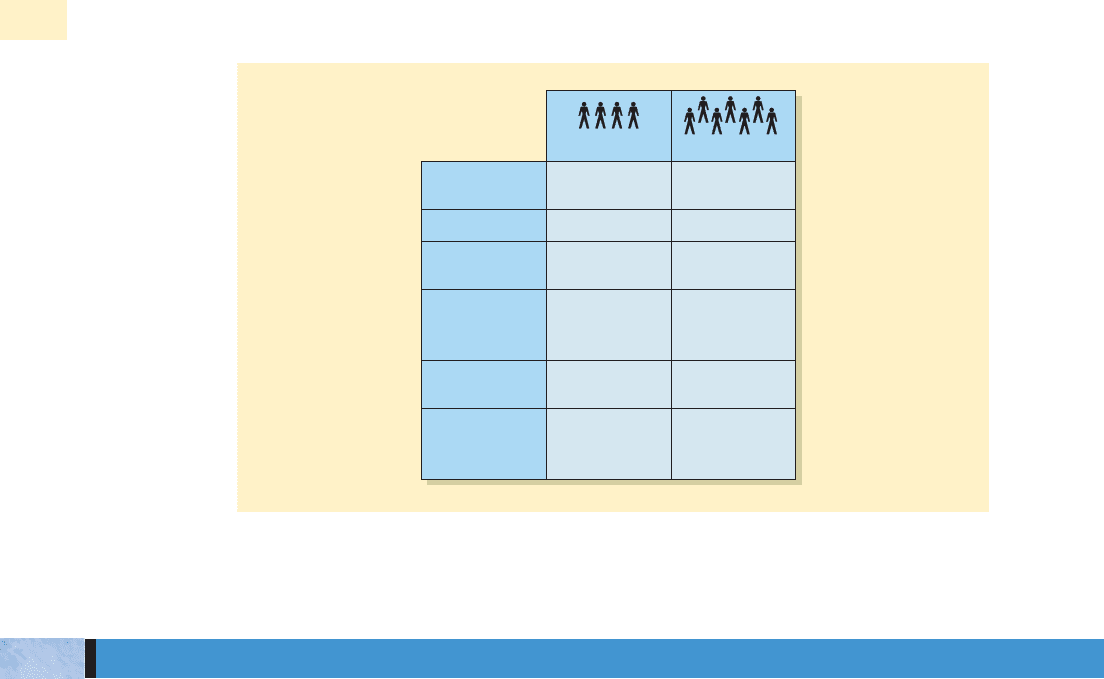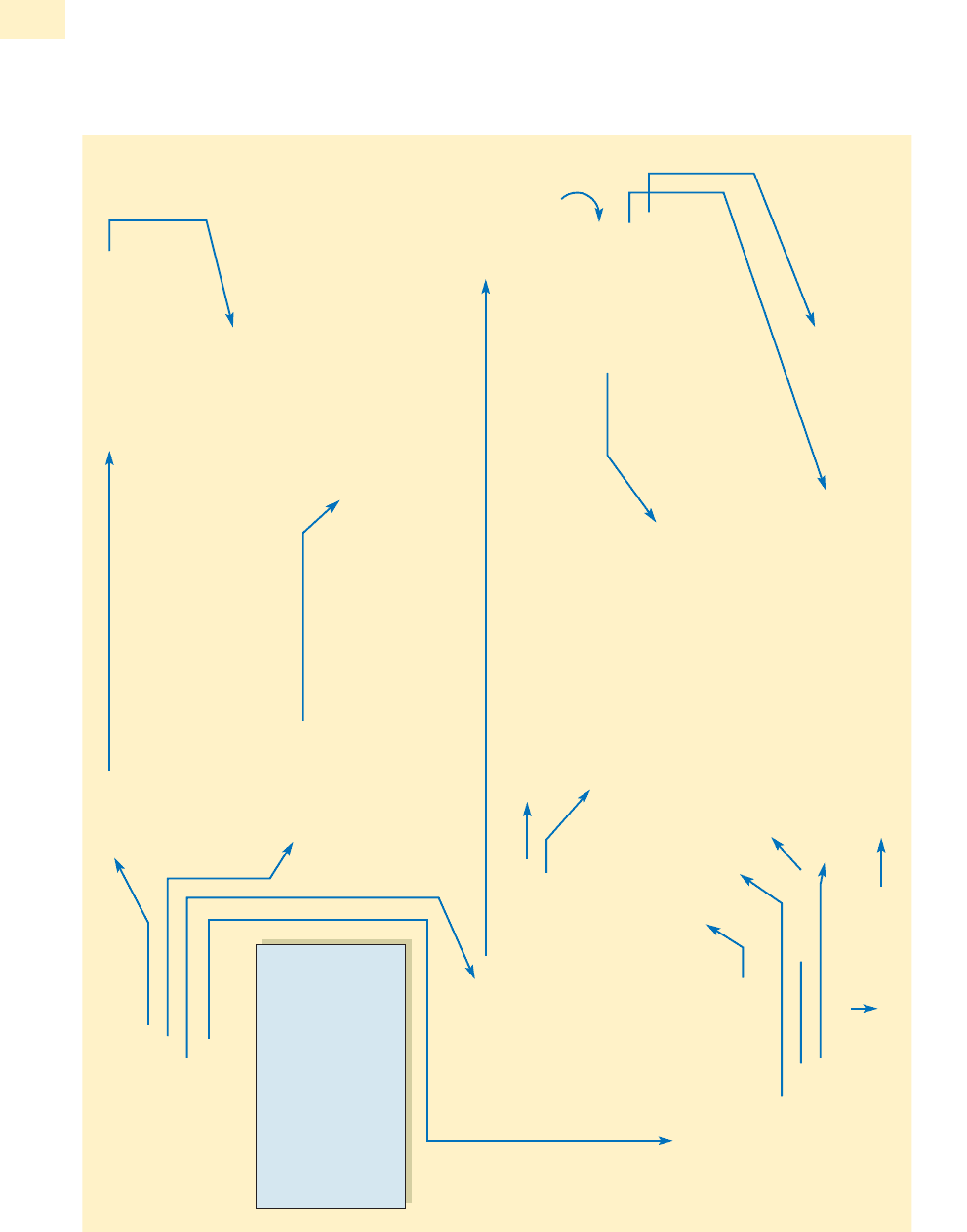Mullins L.J. Management and organisational behaviour, Seventh edition
Подождите немного. Документ загружается.


GROUPS AND
TEAMWORK
Part 5
Part 2
THE
ORGANISATIONAL
SETTING
Part 3
THE ROLE OF
THE MANAGER
Part 6
ORGANISATIONAL
STRUCTURES
Part 7
MANAGEMENT
OF HUMAN
RESOURCES
Part 8
IMPROVING
ORGANISATIONAL
PERFORMANCE
Part 1
MANAGEMENT AND
ORGANISATIONAL
BEHAVIOUR
Part 4
THE
INDIVIDUAL
Part 5
GROUPS AND
TEAMWORK

The importance of donuts

There are more myths, more stereotypes, about
groups and committees than about most subjects
in organizations … Groups there must be.
Individuals must be co-ordinated and their skills
and abilities meshed and merged. But let us not
be mesmerized. Let us realize that a proper
understanding of groups will demonstrate how
difficult they are to manage. Let us pay more
attention to their creation and be more realistic
about their outcomes
Charles Handy
Understanding Organizations, Penguin Books (1993)
Groups and teams are a major feature of
organisational life. The work organisation and
its sub-units are made up of groups of people.
Most activities of the organisation require at
least some degree of co-ordination through the
operation of groups and teamwork. An
understanding of the nature of groups is vital if
the manager is to influence the behaviour of
people in the work situation. The manager must
be aware of the impact of groups and teams,
and their effects on organisational
performance.
LEARNING OUTCOMES
After completing this chapter you should be able to:
explain the meaning and importance of work groups
and teams;
distinguish between groups and teams, and between
formal and informal groups;
explain the main reasons for the formation of groups
and teams;
examine factors which influence group cohesiveness
and performance;
review the characteristics of an effective work group
and assess the impact of technology;
analyse the nature of role relationships and role
conflict;
evaluate the importance of groups and teams for
effective organisational performance.
THE NATURE OF WORK
GROUPS AND TEAMS
13
Photo: E. J. van Koningsveld/Red Arrows

Individuals seldom work in isolation from others. Groups are a characteristic of all
social situations and almost everyone in an organisation will be a member of one or
more groups. Work is a group-based activity and if the organisation is to function effec-
tively it requires good teamwork. The working of groups and the influence they exert
over their membership is an essential feature of human behaviour and of organisa-
tional performance. The manager must use groups in order to achieve a high standard
of work and improve organisational effectiveness.
There are many possible ways of defining what is meant by a group. The essential fea-
ture of a group is that its members regard themselves as belonging to the group.
Although there is no single, accepted definition, most people will readily understand
what constitutes a group. A popular definition defines the group in psychological
terms as:
any number of people who (1) interact with one another; (2) are psychologi-
cally aware of one another; and (3) perceive themselves to be a group.
1
Another useful way of defining a work group is a collection of people who share most,
if not all, of the following characteristics:
■ a definable membership;
■ group consciousness;
■ a sense of shared purpose;
■ interdependence;
■ interaction; and
■ ability to act in a unitary manner.
2
Groups are an essential feature of the work pattern of any organisation. Members of a
group must co-operate in order for work to be carried out, and managers themselves
will work within these groups. People in groups influence each other in many ways
and groups may develop their own hierarchies and leaders. Group pressures can have a
major influence over the behaviour of individual members and their work perform-
ance. The activities of the group are associated with the process of leadership (discussed
in Chapter 8). The style of leadership adopted by the manager has an important influ-
ence on the behaviour of members of the group.
The classical approach to organisation and management tended to ignore the
importance of groups and the social factors at work. The ideas of people such as F. W.
Taylor popularised the concept of the ‘rabble hypothesis’ and the assumption that
people carried out their work, and could be motivated, as solitary individuals un-
affected by others. The human relations approach, however, gave recognition to the
work organisation as a social organisation and to the importance of the group, and
group values and norms, in influencing behaviour at work.
Whereas all teams are, by definition, groups it does not necessarily follow that all
groups are teams. In common usage and literature, including to some extent in this
book, there is however a tendency for the terms ‘groups’ and ‘teams’ to be used inter-
changeably. And it is not easy to distinguish clearly between a group and a team.
3
For
PART 5 GROUPS AND TEAMWORK
THE MEANING AND IMPORTANCE OF GROUPS AND TEAMS
Definitions of
a group
Essential
feature of work
organisations
THE DIFFERENCE BETWEEN GROUPS AND TEAMS
518

example, Crainer refers to ‘teamworking’ as becoming highly fashionable in recent
years. It is a side effect of increasing concentration on working across functional
divides and fits neatly with the trend towards empowerment. However, despite the
extensive literature about teams and teamworking, the basic dynamics of teamworking
often remain clouded and uncertain.
Teams occur when a number of people have a common goal and recognize that their personal
success is dependent on the success of others. They are all interdependent. In practice, this
means that in most teams people will contribute individual skills many of which will be different.
It also means that the full tensions and counter-balance of human behaviour will need to be
demonstrated in the team.
4
According to Holpp, while many people are still paying homage to teams, teamwork,
empowerment and self-management, others have become disillusioned. Holpp poses
the question: what are teams? ‘It’s a simple enough question, but one that’s seldom
asked. We all think we know intuitively what teams are. Guess again. Here are some
questions to help define team configurations.’
■ Are teams going to be natural work groups, or project-and-task oriented?
■ Will they be self-managed or directed?
■ How many people will be on the teams; who’s in charge?
■ How will the teams fit into the organisation’s structure if it shows only boxes and
not circles or other new organisational forms?
Holpp also poses the question: why do you want teams? If teams are just a convenient
way to group under one manager a lot of people who used to work for several downsized
supervisors, don’t bother. But if teams can truly take ownership of work areas and pro-
vide the kind of up-close knowledge that’s unavailable elsewhere, then full speed ahead.
5
Cane suggests that organisations are sometimes unsure whether they have teams or
simply groups of people working together.
It is certainly true to say that any group of people who do not know they are a team cannot be
one. To become a team, a group of individuals needs to have a strong common purpose and to
work towards that purpose rather than individually. They need also to believe that they will
achieve more by co-operation than working individually.
6
Teamwork a fashionable term
Belbin points out that to the extent that teamwork was becoming a fashionable term, it
began to replace the more usual reference to groups and every activity was now being
described as ‘teamwork’. He questions whether it matters if one is talking about groups
or teams and maintains that the confusion in vocabulary should be addressed if the
principles of good teamwork are to be retained. Belbin suggests there are several factors
that characterise the difference between groups and teams. (See Figure 13.1.) The best
differentiator is size: groups can comprise any number of people but teams are smaller
with a membership between (ideally) four and six. The quintessential feature of a small
well-balanced team is that leadership is shared or rotates whereas large groups typically
throw up solo leaders.
7
While acknowledging the work of Belbin it appears that the term ‘group’ is often
used in a more general sense and ‘team’ in a more specific context. We continue to
refer to ‘group’ or ‘team’ according to the particular focus of attention and the vocabu-
lary of the quoted authors.
CHAPTER 13 THE NATURE OF WORK GROUPS AND TEAMS
519

The power of group membership over individual behaviour and work performance was
illustrated clearly in the famous Hawthorne experiments at the Western Electric
Company in America,
8
already referred to in Chapter 3. A significant feature was the
attention drawn to the importance and influence of group values and norms. One
experiment involved the observation of a group of 14 men working in the bank wiring
room. It may be remembered that the men formed their own sub-groups or cliques,
with natural leaders emerging with the consent of the members. Despite a financial
incentive scheme where workers could receive more money the more work they did,
the group decided on 6000 units a day as a fair level of output. This was well below the
level they were capable of producing. Group pressures on individual workers were
stronger than financial incentives offered by management.
Informal social relations
The group developed its own pattern of informal social relations and codes and prac-
tices (‘norms’) of what constituted proper group behaviour.
■ Not to be a ‘rate buster’ – not to produce at too high a rate of output compared
with other members or to exceed the production restriction of the group.
■ Not to be a ‘chiseller’ – not to shirk production or to produce at too low a rate of
output compared with other members of the group.
■ Not to be a ‘squealer’ – not to say anything to the supervisor or management
which might be harmful to other members of the group.
■ Not to be ‘officious’ – people with authority over members of the group, for ex-
ample inspectors, should not take advantage of their seniority or maintain a social
distance from the group.
520
PART 5 GROUPS AND TEAMWORK
Dynamic
interaction
Togetherness
persecution of
opponents
Spirit
Role spread
co-ordination
Convergence
conformism
Style
Mutual
knowledge
understanding
Focus on
leader
Perception
Shared or
rotating
SoloLeadership
Crucial ImmaterialSelection
Limited Medium or
Large
Size
Team Group
Figure 13.1 Differences between a team and a group
(Reproduced with permission from R. Meredith Belbin, Beyond the Team, Butterworth-Heinemann, Division of Reed Educational and
Professional Publishing Ltd, © 2000.)
GROUP VALUES AND NORMS

The group had their own system of sanctions including sarcasm, damaging completed
work, hiding tools, playing tricks on the inspectors, and ostracising those members
who did not conform with the group norms. Threats of physical violence were also
made, and the group developed a system of punishing offenders by ‘binging’ which
involved striking someone a fairly hard blow on the upper part of the arm. This process
of binging also became a recognised method of controlling conflict within the group.
According to Riches, one way to improve team performance is to establish agreed
norms or rules for how the team is to operate and rigorously stick to them. Norms
could address the obligations of individual members to the team, how it will assess its
performance, how it will work together, what motivation systems will be used, how it
will relate to customers, and the mechanisms to facilitate an honest exchange about
the team norms and behaviour.
9
A recent study from the Economic & Social Research Council draws attention to the
importance of social norms among employees and questions whether employees are
guided not only by monetary incentives but also by peer pressure towards social effi-
ciency for the workers as a group. ‘Intuitively, social norms among workers must be
important if they work in teams where bonuses are dependent on group, rather than
individual effort.’
10
(You may see some similarity here with the Bank Wiring Room
experiment, discussed above.)
A ‘summary outline’ of group norms is presented in Figure 13.2 on p. 522.
How people behave and perform as members of a group is as important as their behav-
iour or performance as individuals. Not only must members of a group work well as a
team but each group must also work well with other groups. Harmonious working rela-
tionships and good teamwork help make for a high level of staff morale and work
performance. Effective teamwork is an essential element of modern management prac-
tices such as empowerment, quality circles and total quality management, and how
groups manage change. Teamwork is important in any organisation but may be espe-
cially significant in service industries, such as hospitality organisations where there is a
direct effect on customer satisfaction.
11
According to ACAS (the Arbitration, Conciliation and Advisory Service), teams have
been around for as long as anyone can remember and there can be few organisations
that have not used the term in one sense or another. In a general sense, people talk of
teamwork when they want to emphasise the virtues of co-operation and the need to
make use of the various strengths of employees. Using the term more specifically,
teamworking involves a reorganisation of the way work is carried out. Teamwork can
increase competitiveness by:
■ improving productivity;
■ improving quality and encouraging innovation;
■ taking advantage of the opportunities provided by technological advances;
■ improving employee motivation and commitment.
12
An account of teamwork in a small (40-person) company is given in Management
in Action 13.1.
The general movement towards flatter structures of organisation, wider spans of
control and reducing layers of middle management, together with increasing empow-
erment of employees, all involve greater emphasis on the importance of effective
teamworking. ‘There’s no doubt that effective teamwork is crucial to an organisation’s
efforts to perform better, faster and more profitably than their competitors.’
13
CHAPTER 13 THE NATURE OF WORK GROUPS AND TEAMS
521
THE IMPORTANCE OF TEAMWORK

522
PART 5 GROUPS AND TEAMWORK
THE VALUE OF NORMS
•
Counteracts anonymity
•
Supports small-group identity
•
Are legitimate to group members
•
May not support organisation’s formal goals
•
Provides order
•
Provides standards Often implicit
•
Influences behaviour
•
Embodies the informal ‘shadow’ organisation
CHANGING NORMS
A group is often reluctant to change its
norms, so for change to take place ...
• Get group consensus to change
•
Generate support for change
•
Address as many factors as
possible which will help the change.
GROUP NORMS
•
DEFINITIONS OF NORMS
•
EVOLUTION OF NORMS
•
CHANGING NORMS
•
THE VALUE OF NORMS
UNFREEZING
Develop an awareness of
•
the nature of the change needed
•
the methods planned to achieve the change
•
the needs of those affected
• the ways that progress will be
planned and monitored.
TYPICAL NORM STATEMENTS
•
Around here we always ...
•
It doesn’t do to ...
•
We never ...
•
When that happens we ...
IDENTIFYING NORMS
By observation, interview or question you discover
•
behaviour which gets reinforced or rewarded
•
behaviour which gets discouraged or penalised
EVOLUTION OF NORMS
They may evolve through ...
• modelling behaviour on another ‘prestigious’ group
•
accidental discovery of advantageous behaviour
•
witnessing repeated acts
•
unintended consequences of formal decisions.
DEFINITION
A group norm is an assumption or expectation
held by group members concerning what kind
of behaviour is
• right or wrong
•
good or bad
•
allowed or not allowed
•
appropriate or not appropriate.
PROCESS FOR
IMPLEMENTING
NORM CHANGES
(LEWIN’S CHANGE
MODEL)
STAGE 1 UNFREEZING
STAGE 2 CHANGING
STAGE 3 REFREEZING
CHANGING
•
Defining problems
•
Identifying solutions
•
Implementing solution
REFREEZING
•
Stabilising the situation
•
Building and rebuilding relationships
•
Consolidating the systems
Group norms may evolve over a long
period of time. This can lead to them
becoming
•
rigid
•
anachronistic
•
irrelevent for current situations.
Management’s wishes on their own are sometimes not
sufficiently strong to have enough influence to change norms.
Individual changes are rarely, if ever,
effective in changing the norms
of a group.
Norms are an observable aspect of any
group, in or out of the work setting.
New group members are alert to
signals of acceptance or rejection as
they seek to clarify expectations.
They find them in formal and informal
contacts.
Not necessarily pro- or anti-management
Predictability desirable, avoids chaos
Enables the group to evaluate and
control group behaviour
Language, dress, openness/secrecy,
competitiveness, productivity
Expresses unwritten sometimes unspoken rules May encourage ‘we–they’ attitudes
Figure 13.2 Summary outline of group norms
(Reproduced with permission of Training Learning Consultancy Ltd, Bristol.)

Skills of effective teamworking
From a recent study of Europe’s top companies, Heller refers to the need for new man-
agers and new methods, and includes as a key strategy for a new breed of managers in a
dramatically changed environment: ‘making team-working work – the new, indispen-
sable skill’.
14
The nature and importance of teamwork is discussed further in Chapter 14.
According to Guirdham, the growth of teamwork has led to the increased interest in
interface skills at work.
More and more tasks of contemporary organisations, particularly those in high technology and
service businesses, require teamwork. Taskforces, project teams and committees are key ele-
ments in the modern workplace. Teamwork depends not just on technical competence of the
individuals composing the team, but on their ability to ‘gel’. To work well together, the team
members must have more than just team spirit. They also need collaborative skills – they must
be able to support one another and to handle conflict in such a way that it becomes constructive
rather than destructive.
17
A similar point is made by Ashmos and Nathan: ‘The use of teams has expanded dra-
matically in response to competitive challenges. In fact, one of the most common skills
required by new work practices is the ability to work as a team.’
18
Included in a study of top European companies and ‘making teamwork work’, Heller
refers to the happy teams at Heineken. Part of the cultural strength of Heineken is a
realisation that: ‘the best culture for an organisation is a team culture’; and that ‘any
large organization is a team of teams – and people who have to work together as a
team must also think together as a team’.
19
Heller also lists Heineken’s manifesto for
‘professional team-thinking’ (see Figure 13.3) and maintains that ‘Arguing with any of
these eleven points is absurd’.
CHAPTER 13 THE NATURE OF WORK GROUPS AND TEAMS
523
All of us know in our hearts that the ideal individual for a given job cannot be found … but if
no individual can combine all the necessary qualities of a good manager, a team of individ-
uals certainly can – and often does. Moreover, the whole team is unlikely to step under a
bussimultaneously. This is why it is not the individual but the team that is the instrument of
sustained and enduring success in management.
Antony Jay
15
A successful climbing team involves using management skills essential to any organisation
... The basic planning is the foundation on which the eventual outcome will be decided.
Even if it is the concept of a single person, very quickly more and more people must become
involved, and this is where teamwork and leadership begin.
Sir Chris Bonington
16
Happy teams
at Heineken

524
PART 5 GROUPS AND TEAMWORK
Figure 13.3 Manifesto for professional team-thinking at Heineken
(Reproduced with permission from Robert Heller, In Search of European Excellence, HarperCollins Business © 1997, p. 231.)
1 The aim is to reach the best decision, not just a hasty conclusion or an easy consensus. The team
leader always has the ultimate responsibility for the quality of the decision taken – and therefore, for
the quality of the team-thinking effort that has led up to the decision.
2To produce the best professional team-thinking, the team leader must ensure that ego-trips, petty
office politics and not-invented-here rigidity are explicitly avoided. There should be competition
between ideas – not between individual members of the team.
3 The team-thinking effort must first ensure that the best question to be answered is clearly and
completely formulated.
4 The team-thinking process is iterative – not linear. Therefore, the question may have to be altered
later and the process repeated.
5 The team leader is responsible for seeing that sufficient alternatives and their predicted
consequences have been developed for evaluation by the team.
6 The team leader will thus ask ‘what are our alternatives?’ – and not just ‘what is the answer?’
7 The team leader also recognizes that it is wiser to seek and listen to the ideas of the team before
expressing his or her own ideas and preferences.
8 In any professional team-thinking effort, more ideas will have to be created than used. But any idea
that is rejected will be rejected with courtesy and with a clear explanation as to why it is being
rejected. To behave in this way is not naive, it is just decent and smart.
9A risk/reward equation and a probability of success calculation will be made explicitly before any
important decision is taken.
10 Once a decision is made professionally, the team must implement it professionally.
11 When you think, think. When you act, act.
Teamwork’s own goal
There are limitations to the application of teamwork methods in the workplace writes
Victoria Griffith.
T
eamwork has become a buzzword of 1990s’ man-
agement theory. By grouping employees into problem-
solving taskforces, say the theorists, companies will
empower workers, create cross-departmental fertilisation,
and level ineffective hierarchies.
Yet executives know that, in reality, teams and taskforces
do not always produce the desired results. Part of the
problem may lie with the way teams are organised.
Members may fail to work well together for several rea-
sons, from lack of a sense of humour to clashing goals.
Academics in the US have been studying team dynamics
to try to identify problems.
Too much emphasis on harmony
Teams probably work best when there is room for disagree-
ment. Michael Beer, a professor at Harvard Business
School, says: ‘Team leaders often discourage discord
because they fear it will split the team.’ He studied teams
at Becton Dickinson, the medical equipment group, in the
1980s, and found that efforts to paper over differences
sometimes led to bland recommendations by taskforces.
One working group at the company, for example, said
the division’s overall strategic objective was ‘fortifying our
quality, product cost, and market share strengths, while
also transforming the industry through expanded customer
knowledge and product/service innovation’. The group,
says Beer, offered no organisation guidance as to which
factor was more important and why.
Too much discord
Excessive tension can also destroy team effectiveness. A
study published in the Harvard Business Review in June
1997 found that corporate team members disagreed less
and were more productive when everyone had access to
EXHIBIT 13.1
FT
